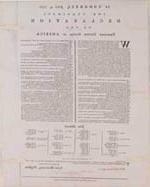Declarations of Independence

In Congress, July 4, 1776. A Declaration by the Representatives of the United States of America, in General Congress Assembled.
Broadside
50 cm x 40 cm
Philadelphia: printed by John Dunlap, [1776]
Online display of document and transcription.

In Congress, July 4, 1776. The Unanimous Declaration of the Thirteen United States of America
Broadside
53 cm x 42.5 cm
Baltimore: printed by Mary Katharine Goddard, [1777]
Online display of document and transcription.

In Congress, July 4, 1776. A Declaration by the Representatives of the United States of America, in General Congress Assembled
Broadside
50.2 cm x 39.4 cm
Salem, Massachusetts-Bay: printed by E. Russell, by order of authority, [1776]
Online display of document and transcription.
"Separate and Equal Station"
Having approved a final version of the Declaration, the Continental Congress sends the manuscript to John Dunlap, who prints a limited number of copies that are soon carried to the army, as well as to the cities and towns of the newly declared United States. Couriers carry the broadsides, and ministers and town officials read them to large gatherings. Local newspapers and other printers also publish their own copies to make sure every citizen may read or hear the tremendous news from Philadelphia.
Questions to Consider
1. What does the typeface of the Dunlap Declaration tell you about the most important words in this document?
2. What is the impact of the different title in the Goddard printing? Where did this printer wish to place the emphasis?
3. Why print the names of all the delegates on the Goddard printing instead of just John Hancock?
4. When was the Goddard version printed? Does the date make a difference?
5. What had changed between the Dunlap printing and the Goddard version?
6. Who might the two faces in the left-hand corner of the Russell version be? Support your answer!
7. What information is included in the Russell version that is not included on the other two printings? What does that information tell us about the secondary purposes of this printing?
Further Exploration
8. The Massachusetts Historical Society holds one of the 25 remaining Dunlap Declarations. Where are the other 24?
9. Why do we celebrate Independence Day on 4 July instead of 2 July?
10. How fast did the news of independence travel? Find out when independence was declared in the largest towns up and down the colonies. Consult Pauline Maier's book Amercan Scripture for hints.
11. Compile a chronology of the drafting and signing of the Declaration of Independence, from Lee's resolution to the Dunlap printing.



